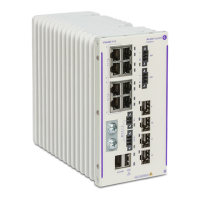Configuring Server Load Balancing Configuring Server Load Balancing on a Switch
OmniSwitch AOS Release 8 Network Configuration Guide December 2017 page 24-10
Configuring Server Load Balancing on a Switch
This section describes how to use the OmniSwitch Command Line Interface (CLI) commands to configure
Server Load Balancing (SLB) on a switch.
When configuring SLB parameters for an SLB cluster, you must perform the following steps:
1 Enable Server Load Balancing on Your Switch. To enable Server Load Balancing (SLB) on a
switch, use the ip slb admin-state command, which is described in “Enabling and Disabling Server Load
Balancing” on page 24-10.
2 Configure the Logical Server Load Balancing Cluster. To configure a logical SLB cluster, use the
ip slb cluster command, which is described in “Configuring and Deleting SLB Clusters” on page 24-11.
3 Assign Physical Servers to the Logical Server Load Balancing Cluster. To add physical servers to a
logical SLB cluster, use the ip slb server ip cluster command, which is described in “Assigning Servers
to and Removing Servers from a Cluster” on page 24-13.
The OmniSwitch implementation of SLB software is preconfigured with the default values shown in the
table in “Server Load Balancing Default Values” on page 24-2. Depending on the requirements of your
network and server farm, you may need to configure more parameters than the mandatory ones described
in this section. See “Modifying Optional Parameters” on page 24-14 for information on configuring
additional SLB parameters.
Enabling and Disabling Server Load Balancing
By default, Server Load Balancing (SLB) is disabled on a switch. The following subsections describe how
to enable and disable SLB on a switch with the ip slb admin-state command.
Enabling SLB
To enable SLB switch wide, use the ip slb admin-state command by entering:
-> ip slb admin-state enable
Disabling SLB
To disable SLB switch wide, use the ip slb admin-state command by entering:
-> ip slb admin-state disable
Note. See “Quick Steps for Configuring Server Load Balancing” on page 24-3 for a brief tutorial on
configuring these mandatory parameters.
Note. Routing (which is enabled by default) must be enabled on a switch or Server Load Balancing will not
operate.
Note. You must enable or disable Server Load Balancing on an entire switch. You cannot enable SLB on a
per port or per slot basis.

